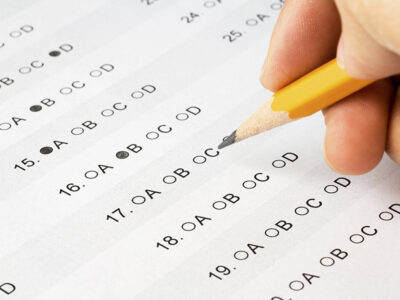Have you ever had a friend ask you to read through an important essay before they turn it in? What about rereading an email or text message before finally hitting send? If so, you have a taste of what the SAT writing section is all about.
The SAT Writing section tests your editing skills–your ability to correct grammatical errors and modify language for clarity and effectiveness. Editing skills are some of the most important skills for success in all college majors, which means they are very important in college admissions decisions.

SAT Writing Overview
The SAT writing test consists of four passages which are accompanied by 44 questions. You will have 35 minutes to read the passages and answer the questions. The passages explore topics related to careers, science, humanities, and history/social studies. But don’t stress too much about the content of the passages themselves. You don’t need any background knowledge in any of the passages’ content to excel in the SAT writing section.
Looking for More SAT Writing Help? Check Out Test Geek’s Free SAT Study Guide.
Instead, you’ll be asked to correct and improve the passages. There will be deliberate errors that require you to apply your knowledge of grammar rules. There will also be certain style choices that require you to use your judgment to determine the best way to communicate an idea. All the passages are written specifically for the SAT, so you won’t recognize anything from your literature, history, or science classes.
Questions that ask you to correct words or phrases in the passages cover such topics as pronoun usage, noun and verb agreement, and punctuation usage. Within the punctuation usage category, the SAT might ask you to correct mistakes in colon, semicolon, comma, dash, or apostrophe usage—the last of which is the focus of this article.
You may be wondering, if questions about apostrophes make up only one part of one section of half the questions of the writing test, why do I need to worry about them at all? It’s true, you will likely only have one or two questions that deal with apostrophe rules on your SAT Writing test—and the same goes for questions about semicolons, colons, dashes, and commas. But knowing a few simple punctuation usage rules is one of the easiest and quickest ways to boost your SAT writing score.
Questions that test your knowledge of grammar rules can be answered very quickly, leaving you more breathing room to tackle the more challenging style questions on the writing test. You never want to leave easy points behind because you didn’t take a few minutes (really, that’s all you need!) to memorize quick rules about apostrophes.
Apostrophe Rules
The apostrophe can be used in two ways: to form contractions and to form possessives.
Contractions
Contractions combine two words into one word. One or more letters disappear and an apostrophe takes their place. It’s really that simple. You’re probably already using contractions correctly.
The trick with contractions is to identify the words the contraction is formed from (in the examples above, “it’s” comes from “it is” and “you’re” comes from “you are”) and make sure that those two words make sense in the sentence where the contraction is placed. It is really that simple. You are probably already using contractions correctly.
Remember that the apostrophe is standing in for the missing letters—exactly where they would be. In “it’s”, the apostrophe takes the place of the “i” in “is” so we cannot write it’s “I’ts” because the letter the apostrophe is repacing is between the “t” and the “s.” Likewise, we cannot write you’re as “yo’ure” because the apostrophe is replacing the “a” that comes between the “u” and the “r”.
Kickstart Your SAT Prep with Test Geek’s Free SAT Study Guide.
Some contractions sound just like possessive pronouns—which never have apostrophes—and can therefore be a little confusing. We’ll cover these in the Common Mistakes section below.
Possessives
Apostrophes are also used to form possessive forms of nouns. Possessive nouns indicate a relationship of ownership between two things.
Sally’s seashells.
Sally owns the seashells so Sally gets apostrophe s added to her name. The owner always gets the apostrophe s and the thing being owned always follows the owner.
Apostrophe s (as used above) is used in two cases:
- All singular nouns
Sally’s seashells, aunt’s car, cat’s toys
If the owner is a singular noun (that is, there’s just one of them), you always use apostrophe s to form the possessive, even if they own many things (like Sally and her many seashells).
Yes, even singular nouns that end in -s become possessive nouns with apostrophe s:
Chris’s pen, class’s teacher, diabetes’s symptoms
These forms do sound a little weird, but as long as you remember that ALL singular nouns get the apostrophe s treatment, you’re good to go. There are so few exceptions (Jesus, Moses, United States), that the SAT won’t ever test you on one of them. Even if it sounds weird, just remember: singular nouns take apostrophe s!
2. Plural nouns that do not end in -s
Children’s books, people’s ideas, sheep’s wool, women’s rights
If the owner is a plural noun that does not end in s, we form the possessive with apostrophe s.
Apostrophe with no additional s is used in one case:
- Plural nouns that end in s
students’ papers, restaurants’ reviews, mothers’ babies
Student’s and students’ are both words, as are restaurant’s and restaurants’, mother’s and mothers’. So how do you know what’s right? Context. Is the author talking about multiple students, restaurants, or mothers? If so, the apostrophe should follow the s. If the author is only talking about one student, restaurant, or mother, the apostrophe should precede the s.
That’s the easy stuff. Now let’s look at some common mistakes.

Common Mistakes
Joint vs. Individual Ownership
Sometimes two nouns own something together. It’s not just your mom’s house; it’s also your dad’s house. So where does the apostrophe go? Only the second noun gets the apostrophe when the owners are next to each other in the sentence:
My mom and dad’s house.
In effect, the two owners act as one owner.
Kate and Lucy’s cat is at the vet. (Kate and Lucy both own the cat.)
Sal and Ari’s parents will pick them up later. (Sal and Ari both “own” their parents.)
However, be careful that the two nouns actually own the other noun jointly. Sometimes, two nouns own things separately. In those cases, both owners get an apostrophe s:
My mom’s and dad’s houses. (There are several houses, one or more that your mom owns and one or more that your dad owns.)
Kate’s and Lucy’s cats are at the vet. (Kate and Lucy each own a cat separately, and they both happen to be at the vet.)
Sal’s and Ari’s parents will pick them up later. (Sal and Ari have different parents, but they will both be picked up later.)
Mrs. Johnson’s and Mr. Franklin’s computers need to be fixed. (Mrs. Johnson and Mr. Franklin each own a computer that needs to be fixed.)
Feeling Overwhelmed? Get 1-on-1 SAT Help from a Test Geek Tutor.
Possessive Pronouns vs. Contractions
We have thus far discussed possessive nouns, which look like regular nouns, but have either an apostrophe s or an apostrophe tacked onto the end. Possessive pronouns are different. Like all pronouns, they replace or refer to named nouns (like Sally, cat, student, or restaurant) that occur earlier in the sentence or in a previous sentence. Possessive pronouns never have apostrophes. Their regular form is possessive. They don’t need an apostrophe.
However, two possessive pronouns we use all the time sound exactly like contractions we use all the time. This means it can be tricky to notice misplaced apostrophes in written sentences. But if we apply the rules we learned above, we should have no problem.
It’s vs. Its
It’s is a contraction of “it is.” If you cannot replace “it’s” with “it is,” it should not be used.
It’s sunny today. It is sunny today. (This works.)
Its is a possessive pronoun. Its stands in for a noun that is in possessive form (a noun that has an apostrophe or an apostrophe s).
The class is very loud today. Its teacher is on vacation. (Its stands in for the possessive noun “the class’s”.) If you can replace “its” with “it is,” its should not be used.
Its teacher is on vacation. It is teacher is on vacation. (This does not work.)
Who’s vs. Whose
Who’s is a contraction of “who is.” If you cannot replace “who’s” with “who is,” who’s should not be used.
Who’s going to college next year? Who is going to college next year? (This works.)
Whose is a possessive pronoun. It stands in for a noun (usually a person) that is in its possessive form.
Whose house is that? It’s Sydney’s house. (Whose refers to the possessive noun Sydney’s). If you can replace “whose” with “who is”, you should not use it.
Who’s house is that? Who is house is that? (This does not work.)
Takeaways
Contractions can always be replaced by the two words they combine.
All singular nouns get apostrophe s to form the possessive, even singular nouns that end in -s.
Plural nouns that do not end in s get apostrophe s to form the possessive.
Plural nouns that end in s get an apostrophe to form the possessive.
If you remember these simple rules, you will be one step closer to a high score on the SAT writing test!









Comments